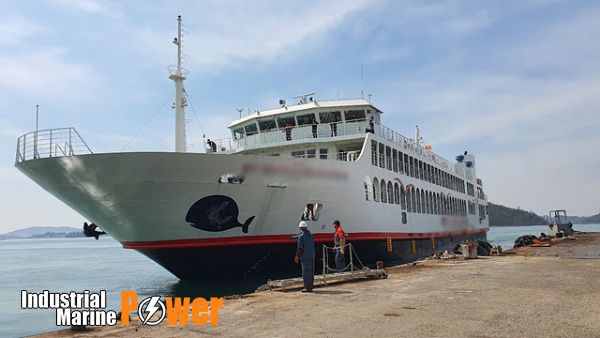
TYPE : RORO PASSENGER FERRY (STERN RAMP)
BLT : SEP. 2021 IN KOREA
ITC : 1,725 T
CLASS : I.R.S (IACS)
LENGTH(O.A) : 82.060M
LENGTH(B.P) : 68.200M
BREADTH(MAX): 16.000M
BREADTH(MOULDED): 15.000M
DEPTH(MOULDED): 3.800M
DRAFT(D.L.W.L) : 2.500M
SCANTLING MLD : 2.800M
CONSTRUCTION: STEEL
RAMP SIZE: 8.5M (L) X 8.0M (B)
ACTUAL DECK CLEARANCE: 4.5M
PASSENGER CAPACITY : ABT 600P
(Passenger seats or beds are not installed. It can be installed later as needed by the buyer.)
PASSENGER CAR : 73EA OR 5TON TRUCK 8EA + CAR 31EA
MAIN ENGINE : CUMMINS QSK-60M 2,230PS(1,641KW) X 1800RPM X 2 SETS
AUX. ENGINE : DOOSAN AD126TI 224KW X 2 SETS
SPEED : MAX (10% DEADWEIGHT,) APPROX. 16KTS
SERVICE SPEED 12~15KTS
NAVI EQUIPMENTS : RADAR(ARPA), GPS PLOTTER, ECHO SOUNDER, AIS, CCTV, GPS COMPASS, VHF, EPIRB, C.B.T., P.A SYSTEM ETC.
OTHER FITTED EQUIPMENTS : BOW THRUSTER, LIFT FOR ELDERLY OR INFIRM PEOPLE , MGPS, ICCP ETC.
PROPELLER : F.P.P(ALBC3) X 2SETS
INSPECTION/DELIVERY : IN KOREA
To whom it may concern
Is this vessel still available? What is the present price?
Please forward GA Plan
Thanks
Reply
Good dy
she is sold
please advise specificions of what you' re looking for so we could assist as we have other candidates
best regards
mamud
ReplyOur company need to know the details including proposed price for father decission.
ReplyA 600 person Roro Passenger Ferry is a type of ship designed to carry both passengers and vehicles, such as cars and trucks, across water bodies. "RORO" stands for "Roll-on/Roll-off," indicating that vehicles can easily drive on and off the ship using a ramp located at the stern of the vessel.
This particular Roro Passenger Ferry was built in Korea in September 2021 and has a tonnage of 1,725T. It is classified by I.R.S, which is one of the members of the International Association of Classification Societies (IACS). The ship is constructed of steel and measures 82.060 meters in overall length and has a maximum breadth of 16.000 meters. It can carry up to 73 passenger cars or 5-ton trucks, and 31 cars in addition to 600 passengers. The ship is powered by two Cummins QSK-60M main engines, each with 2,230PS, and has a maximum speed of approximately 16 knots and a service speed of 12-15 knots.
The ship is equipped with a range of navigation and safety equipment, including radar, GPS plotter, echo sounder, AIS, CCTV, GPS compass, VHF, EPIRB, and a PA system. Other fitted equipment includes a bow thruster, lift for elderly or infirm people, MGPS, and ICCP.
The ship is available for inspection and delivery in Korea. It is worth noting that the ship does not come with passenger seats or beds, but they can be installed later as per the buyer's requirements.
A 600-person RoRo (Roll-on/Roll-off) passenger ferry is a type of vessel designed to transport passengers and their vehicles, such as cars, trucks, or buses, across waterways. The "600 person" specification indicates that the ferry has the capacity to accommodate up to 600 passengers at a time.
RoRo passenger ferries are equipped with ramps or doors, allowing vehicles to easily drive on and off the ferry. This design enables efficient loading and unloading of vehicles and passengers, reducing the time spent at the dock.
Some features of a 600-person RoRo passenger ferry may include:
Passenger capacity: The ferry can accommodate up to 600 passengers, providing seating areas and various amenities to ensure a comfortable journey.
Vehicle capacity: The ferry is designed to carry a specified number of vehicles, such as cars, trucks, or buses, depending on its size and configuration.
Loading ramps: RoRo ferries are equipped with ramps or doors for vehicles to drive on and off the vessel quickly and easily.
Amenities: Depending on the ferry's size and intended use, amenities may include seating areas, restrooms, dining facilities, and lounge areas.
Safety features: Modern RoRo passenger ferries are built to comply with international maritime safety standards, including life-saving equipment, fire prevention systems, and navigational aids.
RoRo passenger ferries are commonly used for short to medium distance routes, such as crossing rivers, bays, or channels, and connecting islands to the mainland. They provide a convenient mode of transportation for both passengers and their vehicles, making them popular in many regions worldwide.
We use cookies to improve your experience. By continuing to use our site, you accept our Cookies, Privacy Policy,Terms and Conditions. Close X